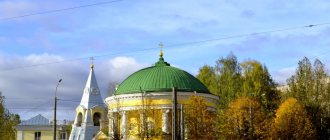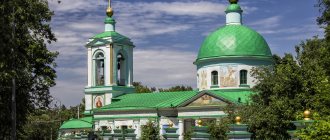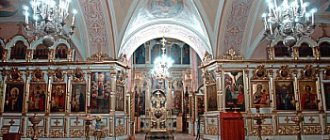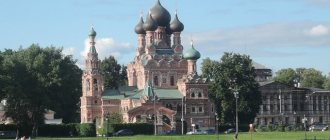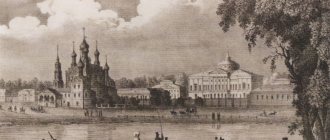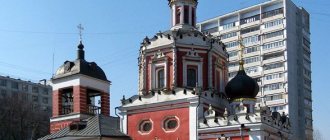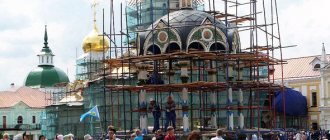Today I will tell you about the Trinity-Izmailovsky Orthodox Cathedral of the Northern capital. I should immediately note that its full name is the Cathedral of the Holy Life-Giving Trinity of the Life Guards Izmailovsky Regiment.
This is another temple that guards the honor and valor of the Russian army. I found out about him completely by accident in the early 90s. Near this church there was once a very popular Trinity Market among the townspeople, where my friend and I decided to visit for the first time.
And that same trip with a completely mundane purpose, shopping, turned into a meeting with a grandiose masterpiece of architecture. I want to say that today, 20 years later, the restored cathedral has become amazingly beautiful.
From its sky-blue dome in sunny weather, the stars smile welcomingly at you. I had previously seen such domes only on churches in Suzdal, Sergiev Posad and Moscow. But in order to move on to the story of today’s Trinity Cathedral, I will begin my story with its historical past.
Story
On May 13, 1828, the sound of bells announced the construction of a new church in honor of the Holy Life-Giving Trinity
The temple was erected in honor of the Life Guards of the Izmailovsky Regiment. It was formed on September 22, 1730 by decree of Empress Anna Ioannovna. The emperor's military formation did not have its own temple, so the soldiers had to visit other parishes. In the early autumn of 1732, a portable church was brought to St. Petersburg , it was assembled and consecrated. It was a “seasonal church” on the banks of the Fontanka, and with the arrival of cold weather it was dismantled again.
Ten years later, a wooden church was built in its place , but it was small for the large number of parishioners. In 1752, the regiment submitted a petition to Empress Elizabeth Petrovna about the need to build a new church. It was built over two years, but during the flood of 1824 it was damaged and could not be restored.
The decision to build a stone church on the site of a destroyed wooden one was made by Nicholas I. According to his order, the temple premises were supposed to accommodate up to three thousand people. Nicholas I, architect V.P. Stasov and engineer P.P. Bazin took part in the construction. The process moved slowly, as every decision was agreed upon with the emperor.
The first stone of the Holy Trinity Monastery was laid on May 13, 1828 , on the feast of Pentecost. The cathedral an expensive seven years to build and was second in size only to St. Isaac's Cathedral, which was already under construction in St. Petersburg at that time. The cathedral was consecrated on May 25, 1835 on the eve of the Holy Trinity.
The emperor was dissatisfied with the wall paintings and the iconostasis, and twice asked to replace everything, but despite this, the temple seemed very light and spacious. The main shrines of the temple were considered: the image of the Resurrection of Christ, the icon of the Dormition of the Mother of God and the icon of the Mother of God “Joy of All Who Sorrow.”
Despite the fact that the temple was a regimental one, the number of civilian parishioners here increased every year. F. Dostoevsky married A. Snitkina here, and the funeral service of the greatest composer A. G. Rubinstein was also held within its walls.
Soviet time
The fate of the Holy Trinity Izmailovo Cathedral changed dramatically with the advent of Soviet power . The cathedral was turned into a regular parish church , and the regiment to which it belonged was disbanded.
On March 15, 1922, during the Divine Liturgy, with a large crowd of parishioners, the new “reformers” demanded that Archpriest Mikhail Cheltsov hand over the main values of the temple. They received a firm refusal from both the rector of the temple and his parishioners, and fearing “big blood” they retreated.
A month later, Father Mikhail was forced to sign a decree on the transfer of church valuables. The parishioners did their best to collect money and managed to buy out most of the property and the shrine. In total, the Bolsheviks took about 2 kilograms of gold and 300 kilograms of silver from the temple. In 1932, the Bolsheviks decided to completely destroy the cathedral , wiping it off the face of the earth. In its place they planned to build a club for workers. Thanks to numerous requests from parishioners, the All-Russian Central Executive Committee temporarily left the cathedral active. In 1939, the temple building was transferred to the theater. Lensovet for a workshop.
The revival of the cathedral began only in 1990-2000, before which there were periodic reports of theft, acts of vandalism and minor damage over time.
Fire
In 2006, a fire that started on the scaffolding of the Holy Trinity Izmailovo Cathedral destroyed the world's largest dome with a wooden base. The firefighters who arrived at the scene of the tragedy were unable to cope with the flames. The fire rose to a height of more than 100 meters, destroying not only the dome, but also the attic floors. The cause of the fire has not been established. The Divine Liturgy in the church began the next morning , but no longer under the dome of the church, but in the open air.
Schedule of services of the Trinity Cathedral
The following services are performed every day:
- 9:30 – confession;
- 10:00 – late liturgy (after which there may be a prayer service and memorial service);
- 13:00, 15:00 – baptismal ceremony;
- 16:00 – prayer at the relics of Saints Matrona, Peter and Fevronia.
Other services are held on certain days of the week. The schedule of additional services can be found on the cathedral website.
- Weddings take place after the liturgy, on odd days of the week, excluding fasting times.
- Prayer service at the icon “The Tsaritsa” – Tuesday, 17:00.
- Prayer service at the icon with the relics of St. George the Victorious - Wednesday, 17:00.
- Evening service – Friday-Sunday or the day before the holiday, 17:00.
- Early Liturgy – Sunday, holidays, 7:00.
Architecture
Izmailovsky Cathedral is a large building with five domes , built in the Empire style. Its height is more than 80 meters. On the facades there are six-column porticoes, in the niches there are figurines of angels made of bronze.
In 1836, marble plaques with the names of officers who died in the battles of Austerlitz, Kulme and Friedland were hung on the walls. The main dome of the cathedral is visible from anywhere in the city at a distance of 20 kilometers.
Tradition says that the blue color of the domes was chosen according to the color of the Izmailovo uniforms
Interior decoration
Inside, the Izmailovsky Cathedral is bright and spacious. The main dome of the cathedral is raised up by four Corinthian columns, it seems to be floating in the air. Turkish banners hung on the walls of the cathedral, reminding of victory in the war with God's help. In 2005, the Column of Glory was restored in front of the shrine, the basis of which is captured Turkish cannons.
Modern life of the temple
I will supplement my story with a story about the current activities of this church. In 2015, the Trinity-Izmailovsky Cathedral solemnly celebrated the 180th anniversary of its consecration, and in 2016 it celebrated the 130th anniversary of the appearance of the “Military Glory” monument. I am pleased to inform you that the restoration was successfully completed in January 2017.
There is a Sunday school for adults here, where students become acquainted with the tenets of the Orthodox faith, communicate, and go on pilgrimages. In the 21st century, a shelter for orphans and those children who found themselves in difficult life situations was revived. This is one of the first joint projects of the church and our state.
Much of the work at the shelter is carried out by volunteers from among the parishioners of the Trinity Cathedral. A community of young St. Petersburg residents has rallied around the church and is functioning dynamically. She even publishes her own magazine, Izmailovsky Vestnik.
There is interesting information about the churches that are assigned to the cathedral here.
Column of Glory
On the eastern side of the temple is the Column of Glory, built in honor of the victory in the Russian-Turkish war. An unusual monument designed by the architect Grimm was opened in 1886 with the personal participation of Emperor Alexander III.
The 28-meter-high monument is made from 108 cast-iron cannons that came to St. Petersburg as war trophies. Above the guns, placed in 5 tiers, rises an allegorical sculpture of Glory, the goddess Nike, holding a laurel wreath in her hand.
Below, on a granite pedestal, are boards where the main battles of the Russian-Turkish war are listed and the distinguished commanders are named.
In 1930, the monument was removed and melted down, planning to erect a monument to the Decembrists on the site of the memorial, which was never built. Today there is an exact copy of the old Column of Glory, made in 2005.
Charity
In the 19th century, a regimental hospital for Izmailovo soldiers operated on the territory of the temple. Later, a shelter for orphaned children, the “Society for Relief of the Poor,” was established here. Trinity Cathedral was considered the main charitable and spiritual center of St. Petersburg.
Nowadays, charity continues to flourish in the temple; there are such promotions as a free lunch that everyone in need can receive. This tradition began relatively recently - in 2006. With the support of sponsors, the cathedral can feed anyone who asks for help in a specially designated dining room.
Trinity Cathedral in St. Petersburg has been supporting charity for many years, collecting donations, books and stationery for children in need.
Architectural ideas
Trinity Cathedral is one of the most prominent buildings in the city. Its five domes are made in sky blue, despite the fact that the wooden church's domes were originally green. The idea of blue domes with large gold stars was proposed by Emperor Nicholas I. Four porticoes with six columns decorate the façade of the building. Bronze angels by S.I. Galberga are located in the western part of the temple.
There are several architectural styles in the building:
| Empire style | This style is expressed in the presence of columns, sculptures, and strict symmetries. Empire style symbolizes the power and wealth of the emperor. It was brought to Russia by French architects in the second half of the 19th century. |
| Neoclassicism | This is a kind of return to the canons of classicism and antiquity. This trend also echoes the Renaissance. |
| Pseudo-Russian style | In the wake of the rise of the planting of the European style, movements to promote the ancient Russian canons of art and architecture began to emerge in Russia. Temples were built with deliberate imitation of Russian-Byzantine architecture in order to show the memory of the roots of the Russian Orthodox Church and preserve it through the centuries. In the Trinity Cathedral, the architectural style is expressed in the white color of the stone, classical forms and narrow elongated windows. |
,The original drawing of the Trinity Cathedral in St. Petersburg
The Trinity Cathedral in St. Petersburg is a classic example of the architectural trends of its time.
Photo of the Trinity Cathedral in St. Petersburg
It’s hard not to notice the Trinity Cathedral among the gray mass of high-rise buildings; it’s the fourth tallest building in St. Petersburg!
The photo helps to see the “uniform” blue of the domes of the Trinity Cathedral and understand that they are oriented unusually, towards the cardinal directions.
